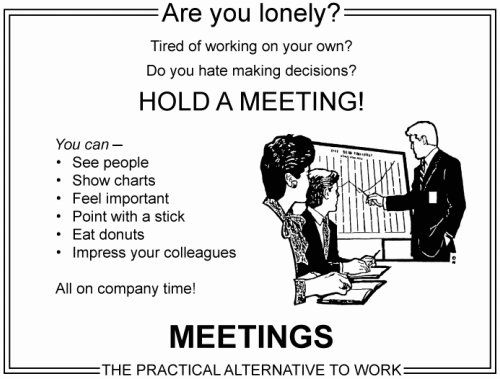
Almost all meetings are just power-plays in disguise.
Years of my life have been wasted in useless meetings. At a large company, meetings are standard. Get a few people together to talk about a problem. Sounds easy, right?
But instead of a quick resolution, you have to book a conference room for two days from now. Then, you invite stakeholders. Someone suggests so-and-so should attend too. More invites.
When you finally meet, what happens? Nothing, because everyone ends up in a power-play.
Let’s take a look at three common useless meetings and ways we can fix them.
Weekly Team/Status Meetings
Usually someone with direct reports runs this type of meeting. Once a week, for an hour or so, there’s a loose agenda. The manager goes over administrative stuff — stuff that’s going on at the company, stuff that’s going on in your department, stuff on product direction. You can even ask questions! Then, you go around the room to talk about what you accomplished that week.
Nothing useful ever happens in these meetings. Have you ever looked forward to this meeting? No. You surf the internet on your laptop while waiting for lunch time to roll around.
Managers are establishing their authority over everyone. They speak. You listen and don’t speak until spoken to. The danger is that this might tempt you to try to establish that you’re an important person too. You fluff up your weekly status and make it seem like you’re super busy all the time.
What’s the fix?
Try alternative forms of keeping everyone updated. Managers, do you really need to get everyone in a room for an hour? Have everyone send an email update to the team instead. It only takes a few minutes to write up updates to share for the week. Try daily updates or other frequencies that are most optimal for your team.
If you’re not the manager, suggest this method to yours. Any good manager will gladly accept feedback on how to improve the way the team operates.

Senior Executives Meeting
Here’s where you and your team have to meet with senior executives to talk about how your product is doing and next steps you’re going to take. This type of meeting takes place maybe once a month.
This, too, is a big power-play by the executives. They look at what you’ve accomplished, and they’re quick to judge what they like or don’t. Even though months of your efforts have gone towards building an awesome feature that your customers have been wanting, it gets axed because an exec didn’t like it.
These meetings usually just set the team and the product back. You now have to include what the exec wants in the product — not because they’re talking to customers every day, not because they have the data to back up their claims. It’s because they need to establish some authority.
What’s the fix?
Executives, keep your ego in check. Learn to trust your team. They probably know more about the customer than you do. You hired them because they are the best at what they do. They have pored over the metrics and have the best sense on what will result in customer happiness.
Use meetings to find out issues that impede execution. Are people short on resources? Are they dependent on someone from another department who’s being difficult? Remove the roadblocks!
For regular employees, defend your position with data. The exec can’t argue with you if the metrics show that a particular feature will increase sales by 10%. Don’t let their position of power waste your time.
Product Planning Meeting
This is my favorite useless meeting because its original purpose is quite constructive. You’re supposed to be planning out the what and when of building for your product, but what usually happens is everyone needs an explanation of features and why they’re necessary. That is always a long conversation.
Then everyone argues about what’s important. It’s the ultimate struggle to feel like you have some power. If your feature makes it into the product, you feel like you have a bigger impact.
Since everyone at the meeting does this, you’ll need to call another meeting to finish the planning. Five meetings later, you finally finish planning.
What’s the fix?
Everyone should come prepared to the meeting already! Road maps, user stories, and numbers should be sent out beforehand. The team can review and internalize the information and even have high level estimates for the level of effort needed.
This way, you’ll set a good tone for the meeting. It will be about what features you can actually fit into a sprint, based on priority and informed argument. If you don’t already use an agile development process, please consider it. It helps set a cadence for the team.

Now that I know about about power-play meetings, how can I gain the upper hand?
That really depends on what your goal at the company is.
Hope no one notices.
If you want to be mediocre and get paid, then just follow the crowd. Some people are fine with showing up and doing exactly what they need to do, especially in certain working situations and environments. There’s nothing wrong with that. You get a nice paycheck and you can continue to support your lifestyle.
Promotions and fat raises.
Learn the intricacies of the power-play. You’ll have to follow the meeting playbook to appease the people above you.
The goal here is to get recognized and impress people. Call your own meetings when you have issues to resolve and be the one to run them. You’ll automatically be known as the person in charge when you become directly involved in decision-making.
Understand that these meetings will take up a lot of time but you still need to execute on deliverables. Let everyone else know how busy you are as a result. The upside is that you can fix the common meeting downfalls mentioned above and be known for running really effective meetings.
Be the change.
This is for people who like where they work and want to change it for the better. Useless meetings is a serious cultural problem that companies face. Run meetings differently to change that culture.
Try not to have any meetings unless absolutely necessary, and if they are, keep them short. When issues arise, talk to the relevant people immediately. You can usually make more decisions in a five-minute direct conversation than you can in a one-hour meeting.
Designate no-meeting days. This will allow your team to have long periods of time to concentrate on hard problems. If you know anything about the maker’s schedule versus the manager’s schedule, then you’ll understand how meetings can ruin your productivity.
Liked this guest post? Subscribe to our free newsletter for more great content on management, productivity, and company culture!
Images: [1 & 2] Victor1558.
